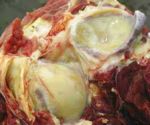Difference between revisions of "Osteoarthritis - Donkey"
| (5 intermediate revisions by the same user not shown) | |||
| Line 1: | Line 1: | ||
| + | [[Image:Elderly donkey joint.jpg|right|thumb|150px|<small><center>The shoulder joint of a 37-year-old donkey euthanased for hyperlipaemia and without any clinical history of significant lameness. (Image courtesy of [http://drupal.thedonkeysanctuary.org.uk The Donkey Sanctuary])</center></small>]] | ||
| + | The high incidence of this condition should not come as any surprise when dealing with elderly animals. Donkeys in the UK can live an unprecedented long life and they often just outlive the natural lifespan of their joints. In donkeys, spinal, especially cervical, regions are commonly affected as are proximal hind limb and shoulder joints and distal limbs. | ||
| + | Much information can be gleaned by standing back and watching the animal. Many donkeys with chronic osteoarthritis of the distal limbs will constantly weight shift. Also, enquire of the owner if the animal is lying down more frequently or for longer periods of time. This clinical sign of the condition can also increase the chances of intestinal impaction and [[Colic - Donkey|colic]]. | ||
| + | |||
| + | Again, the stoical and uncomplaining nature of the donkey can be reflected at post-mortem when high-grade and normally clinically significant lesions can be found despite a history of relative soundness in the individual. Donkeys are very good at suffering in silence and even a small deviation from soundness may indicate significant pain and should be investigated. | ||
| + | |||
| + | A '''stringhalt-like condition''' is seen in a number of elderly donkeys. The involuntary flexion of one or both hind limbs can be quite severe and result in a most bizarre gait in some individuals. There is anecdotal evidence that the condition worsens during cold weather. In general, affected individuals do not appear unduly incapacitated nor do they improve on anti-inflammatory medication, although osteoarthritis of the affected joints must always be borne in mind. | ||
| + | |||
| + | ==Literature Search== | ||
| + | [[File:CABI logo.jpg|left|90px]] | ||
| + | |||
| + | |||
| + | Use these links to find recent scientific publications via CAB Abstracts (log in required unless accessing from a subscribing organisation). | ||
| + | <br><br><br> | ||
| + | [http://www.cabdirect.org/search.html?rowId=1&options1=AND&q1=osteoarthritis&occuring1=freetext&rowId=2&options2=AND&q2=donkeys&occuring2=od&rowId=3&options3=AND&q3=&occuring3=freetext&x=76&y=11&publishedstart=yyyy&publishedend=yyyy&calendarInput=yyyy-mm-dd&la=any&it=any&show=all Osteoarthritis in donkeys related publications] | ||
==References== | ==References== | ||
| Line 12: | Line 27: | ||
|sublink1 =Geriatric Donkey | |sublink1 =Geriatric Donkey | ||
|subtext1 =Geriatric Donkey | |subtext1 =Geriatric Donkey | ||
| − | |||
|pagetype=Donkey | |pagetype=Donkey | ||
}} | }} | ||
| + | {{infotable | ||
| + | |Maintitle = [[Sponsors#The Donkey Sanctuary|This section was sponsored and content provided by '''THE DONKEY SANCTUARY''']] | ||
| + | |Maintitlebackcolour = B4CDCD | ||
| + | }} | ||
| + | [[Category:Donkey]] | ||
| + | [[Category:Musculoskeletal_Disorders_-_Donkey]][[Category:Geriatric_Donkey]] | ||
Latest revision as of 22:32, 18 October 2010

The high incidence of this condition should not come as any surprise when dealing with elderly animals. Donkeys in the UK can live an unprecedented long life and they often just outlive the natural lifespan of their joints. In donkeys, spinal, especially cervical, regions are commonly affected as are proximal hind limb and shoulder joints and distal limbs.
Much information can be gleaned by standing back and watching the animal. Many donkeys with chronic osteoarthritis of the distal limbs will constantly weight shift. Also, enquire of the owner if the animal is lying down more frequently or for longer periods of time. This clinical sign of the condition can also increase the chances of intestinal impaction and colic.
Again, the stoical and uncomplaining nature of the donkey can be reflected at post-mortem when high-grade and normally clinically significant lesions can be found despite a history of relative soundness in the individual. Donkeys are very good at suffering in silence and even a small deviation from soundness may indicate significant pain and should be investigated.
A stringhalt-like condition is seen in a number of elderly donkeys. The involuntary flexion of one or both hind limbs can be quite severe and result in a most bizarre gait in some individuals. There is anecdotal evidence that the condition worsens during cold weather. In general, affected individuals do not appear unduly incapacitated nor do they improve on anti-inflammatory medication, although osteoarthritis of the affected joints must always be borne in mind.
Literature Search
Use these links to find recent scientific publications via CAB Abstracts (log in required unless accessing from a subscribing organisation).
Osteoarthritis in donkeys related publications
References
- Sprayson, T. (2008) The care of the geriatric donkey In Svendsen, E.D., Duncan, J. and Hadrill, D. (2008) The Professional Handbook of the Donkey, 4th edition, Whittet Books, Chapter 13
|
|
This section was sponsored and content provided by THE DONKEY SANCTUARY |
|---|
